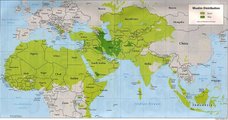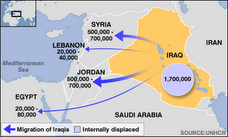by Tom Engelhardt
Iraq by the Numbers: Surging Past the Gates of Hell
Sometimes, numbers can strip human beings of just about everything that makes us what we are. Numbers can silence pain, erase love, obliterate emotion, and blur individuality. But sometimes numbers can also tell a necessary story in ways nothing else can.
-Since (January)...., 28,500 new American troops have surged into that country, mostly in and around Baghdad
-Number of American troops in Iraq, June 2007: Approximately 156,000.
-Number of American troops in Iraq, May 1, 2003, Approximately 130,000.
-Number of Sunni insurgents in Iraq, May 2007: At least 100,000, according to Asia Times correspondent Pepe Escobar on his most recent visit to the country.
-American military dead in the surge months, February 1–June 26, 2007: 481.
-American military dead, February–June 2006: 292.
-Number of contractors killed in the first three months of 2007: At least 146.
-Number of armed "private contractors" now in Iraq: at least 20,000–30,000, according to the Washington Post. (Jeremy Scahill, author of the bestseller Blackwater, puts the figure for all private contractors in Iraq at 126,000.)
-Number of attacks on U.S. troops and allied Iraqi forces, April 2007: 4,900.
-Percentage of U.S. deaths from roadside bombs (IEDs): 70.9% in May 2007; 35% in February 2007 as the surge was beginning.
-Percentage of registered U.S. supply convoys (guarded by private contractors) attacked: 14.7% in 2007 (through May 10); 9.1% in 2006; 5.4% in 2005.
-Percentage of Baghdad not controlled by U.S. (and Iraqi) security forces more than four months into the surge: 60%, according to the U.S. military.
-Number of attacks on the Green Zone, the fortified heart of Baghdad where the new $600 million American embassy is rising and the Iraqi government largely resides: More than 80 between March and the beginning of June, 2007, according to a UN report. (These attacks, by mortar or rocket, from "pacified" Red-Zone Baghdad, are on the rise and now occur nearly daily.)
-Size of U.S. embassy staff in Baghdad: More than 1,000 Americans and 4,000 third-country nationals.
-U.S. air strikes in Iraq during the surge months: Air Force planes are dropping bombs at more than twice the rate of a year ago, according to the Associated Press. "Close support missions" are up 30–40%. And this surge of air power seems, from recent news reports, still to be on the rise. In the early stages of the recent surge operation against the city of Baquba in Diyala province, for instance, Michael R. Gordon of the New York Times reported that "American forces.... fired more than 20 satellite-guided rockets into western Baquba," while Apache helicopters attacked "enemy fighters." ABC News recently reported that the Air Force has brought B-1 bombers in for missions on the outskirts of Baghdad.
-Number of years Gen. Petraeus, commander of the surge operation, predicts that the U.S. will have to be engaged in counterinsurgency operations in Iraq to have hopes of achieving success: 9–10 years. ("In fact, typically, I think historically, counterinsurgency operations have gone at least nine or 10 years.")
-Number of Iraqi police, trained by Americans, who were not on duty as of January 2007, just before the surge plan was put into operation: Approximately 32,000 out of a force of 188,000
-Amount of "reconstruction" money invested in the CIA's key asset in the new Iraq, the Iraqi National Intelligence Service: $3 billion, according to Asia Times correspondent Pepe Escobar.
-Number of Iraqi "Kit Carson scouts" being trained in the just-captured western part of Baquba: More than 100.
-Number of Iraqis who have fled their country since 2003: Estimated to be between 2 million and 2.2 million, or nearly one in ten Iraqis. According to independent reporter Dahr Jamail, at least 50,000 more refugees are fleeing the country every month.
-Number of Iraqi refugees who have been accepted by the United States: Fewer than 500, according to Bob Woodruff of ABC News; 701, according to Agence France Presse. (Under international and congressional pressure, the Bush administration has finally agreed to admit another 7,000 Iraqis by year's end.)
-Number of Iraqis who are now internal refugees in Iraq, largely due to sectarian violence since 2003: At least 1.9 million, according to the UN. (A recent Red Crescent Society report, based on a survey taken in Iraq, indicates that internal refugees have quadrupled since January 2007, and are up eight-fold since June 2006.)
-Percentage of refugees, internal and external, under 12: 55%, according to the President of the Red Crescent Society.
-Percentage of Baghdadi children, 3 to 10, exposed to a major traumatic event in the last two years: 47%, according to a World Health Organization survey of 600 children. 14% of them showed symptoms of post-traumatic stress disorder. In another study of 1,090 adolescents in Mosul, that figure reached 30%.
-Number of Iraqi doctors who have fled the country since 2003: An estimated 12,000 of the country's 34,000 registered doctors since 2003, according to the Iraqi Medical Association. The Association reports that another 2,000 doctors have been slain in those years.
-Number of Iraqi refugees created since UN Secretary-General Ban Ki-Moon declared a "humanitarian crisis" for Iraq in January 2007: An estimated 250,000.
-Percentage of Iraqis now living on less than $1 a day, according to the UN: 54%.
-Iraq's per-capita annual income: $3,600 in 1980; $860 in 2001 (after a decade of UN sanctions); $530 at the end of 2003, according to Asia Times correspondent Pepe Escobar, who estimates that the number may now have fallen below $400. Unemployment in Iraq is at around 60%.
-Percentage of Iraqis who do not have regular access to clean water: 70%, according to the World Health Organization. (80% "lack effective sanitation.")
-Rate of chronic child malnutrition: 21%, according to the World Health Organization. (Rates of child malnutrition had already nearly doubled by 2004, only 20 months after the U.S. invasion.) -According to UNICEF, "about one in 10 children under five in Iraq are underweight."
-Number of Iraqis held in American prisons in their own country: 17,000 by March 2007, almost 20,000 by May 2007 and surging.
-Number of Iraqis detained in Baquba alone in one week in June in Operation Phantom Thunder: more than 700.
-Average number of Iraqis who died violently each day in 2006: 100 – and this is undoubtedly an underestimate, since not all deaths are reported.
-Number of Iraqis who have died violently (based on the above average) since Ban Ki-Moon declared a "humanitarian crisis" for Iraq in January 2007: 15,000 – again certainly an undercount.
-Number of Iraqis who died during the week of June 17–23, 2007, according to the careful daily tally from media reports offered at the website Antiwar.com: 763 or an average of 109 media-reported deaths a day. (June 17: 74; June 18: 149; June 19: 169; June 20: 116; June 21: 58; June 22: 122; June 23: 75.)
-Percentage of seriously wounded who don't survive in emergency rooms and intensive-care units, due to lack of drugs, equipment, and staff: Nearly 70%, according to the World Health Organization.
-Number of university professors who have been killed since the invasion of 2003: More than 200, according to the Iraqi Ministry of Higher Education.
-The value of an Iraqi life: A maximum of $2,500 in "consolation" or "solatia" payments made by the American military to Iraqi civilians who died "as a result of U.S. and coalition forces' actions during combat," according to a U.S. Government Accountability Office (GAO) report. These payments imply no legal responsibility for the killings. For rare "extraordinary cases" (and let's not even imagine what these might be), payments of up to $10,000 were approved last year, with the authorization of a division commander.
-The value of an Iraqi car, destroyed by American forces: $2,500 would not be unusual, and conceivably the full value of the car, according to the same GAO report. A former Army judge advocate, who served in Iraq, has commented: "[T]he full market value may be paid for a Toyota run over by a tank in the course of a non-combat related accident, but only $2,500 may be paid for the death of a child shot in the crossfire."
June 28, 2007
Tom Engelhardt [send him mail] is editor of TomDispatch.com, a project of the Nation Institute. He is the author of several books, including The Last Days of Publishing: A Novel, The End of Victory Culture, and most recently, Mission Unaccomplished (Nation Books), the first collection of Tomdispatch interviews. His new blog is The Notion.
Saturday, July 7, 2007
Subscribe to:
Post Comments (Atom)





No comments:
Post a Comment